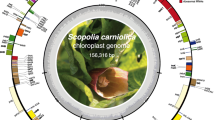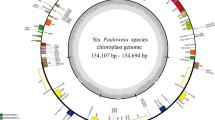Abstract
Intron sequences of the chloroplast generps16 from 46 species were used to examine phylogenetic relationships indicated by nrDNA ITS sequence variation in the tribeSileneae (Caryophyllaceae, Caryophylloideae). This region has previously not been utilized for phylogenetic purposes but the results presented here suggest that it is a consistent and valuable complement to the ITS sequences. Therps16 intron trees are largely congruent with the ITS trees. All the major hypotheses suggested by the ITS data are supported, often at similar bootstrap levels. The joint usage ofrps16 intron and ITS sequences provides a powerful tool for resolving many of the difficult taxonomic issues in the tribeSileneae.
Similar content being viewed by others
References
Baldwin, B. G., Sanderson, M. J., Porter, J. M., Wojciechowski, M. F., Campbell, C. S., Donoghue, M. J., 1995: The ITS region of nuclear ribosomal DNA: a valuable source of evidence on angiosperm phylogeny. — Ann. Missouri Bot. Gard.82: 247–277.
Böhle, U.-R., Hilger, H., Cerff, R., Martin, W. F., 1994: Non-coding chloroplast DNA for plant molecular systematics at the infrageneric level. — InSchierwater, B., Streit, B., Wagner, G. P., DeSalle, R., (Eds): Molecular ecology and evolution: approaches and applications, pp. 391–402. — Basel: Birkhäuser.
Bremer, K., 1988: The limits of amino acid sequence data in angiosperm phylogenetic reconstruction. — Evolution42: 795–803.
Chowdhuri, P. K., 1957: Studies in the genusSilene. — Notes Roy. Bot. Gard. Edinburgh22: 221–278.
Downie, S. R., Palmer, J. D., 1992: Use of chloroplast DNA rearrangements in reconstructing plant phylogeny. — InSoltis, P. S., Soltis, D. E., Doyle, J. E., (Eds): Molecular systematics of plants, pp. 14–35. — New York: Chapman & Hall.
—, 1996: Phylogenetic analysis ofApiaceae subfamilyApioideae using nucleotide sequences from the chloroplastrpoCl intron. — Molec. Phylogenet. Evol.6: 1–18.
Doyle, J. J., 1992: Gene trees and species trees: molecular systematics as one-character taxonomy. — Syst. Bot.17: 144–163.
—, 1995: Multiple independent losses of two genes and one intron from legume chloroplast genomes. — Syst. Bot.20: 272–294.
Ehrendorfer, F., Manén, J.-F., Natali, A., 1994: cpDNA intergene sequences corroborate restriction site data for reconstructingRubiaceae phylogeny. — Pl. Syst. Evol.190: 245–258.
Eriksson, T., Wikström, N., 1995: AutoDecay. Version 3.03. — Stockholm: Stockholms Universitet (distributed by the authors).
Farris, J. S., 1989: The retention index and the rescaled consistency index. — Cladistics5: 417–419.
Felsenstein, J., 1978: Cases in which parsimony and compatibility methods will be positively misleading. — Syst. Zool.27: 401–410.
Gielly, L., Taberlet, P., 1994: The use of chloroplast DNA to resolve plant phylogenies: noncoding versusrbcL sequences. — Molec. Biol. Evol.11: 769–777.
—, 1996: Phylogenetic use of noncoding regions in the genusGentiana L.: chloroplasttrnL (UAA) intron versus nuclear ribosomal internal transcribed spacer sequences. — Molec. Phylogenet. Evol.5: 460–466.
Golenberg, E. M., Clegg, M. T., Durbin, M. L., Doebley, J., Ma, D. P., 1993: Evolution of a noncoding region of the chloroplast genome. — Molec. Phylogenet. Evol.2: 52–64.
Greuter, W., 1995:Silene (Caryophyllaceae) in Greece: a subgeneric and sectional classification. — Taxon44: 543–581.
Harshman, J., 1994: The effect of irrelevant characters to bootstrap values. — Syst. Biol.43: 419–424.
Holmgren, K. P., Holmgren, H. N., Barnett, L. C., 1990: Index Herbariorum 1: The herbaria of the world, 8th edn. — Regnum Veg.120.
Hoot, S., Culham, A., Crane, P. R., 1995: The utility ofatpB gene sequences in resolving phylogenetic relationships: comparison withrbcL and 18S ribosomal DNA sequences in theLardizabalaceae. — Ann. Missouri Bot. Gard.82: 194–207.
Johnson, L. A., Soltis, D. E., 1995: Phylogenetic inference inSaxifragaceae sensu stricto andGilia (Polemoniaceae) usingmatK sequences. — Ann. Missouri Bot. Gard.82: 149–175.
Jordan, W. C., Courtney, M. W., Neigel, J. E., 1996: Low levels of intraspecific genetic variation at a rapidly evolving chloroplast DNA locus in North American duckweeds (Lemnaceae). — Amer. J. Bot.83: 430–439.
Lidén, M., Fukuhara, T., Rylander, J., Oxelman, B., 1997: The phylogeny and classification ofFumariaceae with emphasis onDicentra sensu lato based on the chloroplast generps16 intron. — Pl. Syst. Evol.206: 411–420.
Maddison, W. P., Maddison, D. R., 1992: MacClade: analysis of phylogeny and character evolution. Version 3.05 — Sunderland, Mass.: Sinauer.
Nagano, Y., Matsuno, R., Sasaki, Y., 1991: Sequence and transcriptional analysis of the gene clustertrnQ-zfpA-psaI-ORF231-petA in pea chloroplasts. — Curr. Genet.20: 431–436.
Neuhaus, H., Scholz, A., Link, G., 1989: Structure and organisation of a split chloroplast gene from mustard (Sinapis alba): ribosomal protein generps16 reveals unusual transcriptional features and complex RNA maturation. — Curr. Genet.15: 63–70.
Ohyama, K., Fukuzawa, H., Kohchi, T., Shirai, H., Sano, T., Sano, S., Umesono, K., Shiki, Y., Takeuchi, M., Chang, Z., Aota, S., Inokuchi, H., Ozeki, H., 1986: Chloroplast gene organization deduced from complete sequence of liverwortMarchantia polymorpha chloroplast DNA. — Nature322: 572–574.
Olmstead, R. G., Reeves, P. A., 1995: Evidence for the polyphyly of theScrophulariaceae based on chloroplastrbcL andndsF sequences. — Ann. Missouri Bot. Gard.82: 176–193.
Oxelman, B., 1995: Systematic studies in the genusSilene L. (Caryophyllaceae) — morphological and molecular approaches. — Ph.D. thesis, Västra Frölunda: Göteborgs Universitet.
—, 1996: LongRangerTM gels versus standard polyacrylamide gels on ALFExpressTM automated sequencers. — FMC Resolutions12(2): 2–4.
—, 1995: Generic boundaries in the tribeSileneae (Caryophyllaceae) as inferred from nuclear rDNA sequences. — Taxon44: 525–542.
Pamilo, P., Nei, M., 1991: Relationships between gene trees and species trees. — Molec. Biol. Evol.5: 568–583.
Rieseberg, L. H., Soltis, D. E., 1991: Phylogenetic consequences of cytoplasmic gene flow in plants. — Evol. Trends Pl.5: 65–84.
Rohrbach, P., 1869: Monographie der GattungSilene. — Leipzig: Engelmann.
Sexton, D., Jones, J. T., Mullet, J. E., 1990: Sequence and transcriptional analysis of the barley ctDNA region upstream of psbD-psbC encoding trnK(UUU), rps16, trnQ(UUG), psbK, psbI, and trnS(GCU). — Curr. Genet.17: 445–454.
Sheen, J.-Y., Seed, B., 1988: Electrolyte gradient gels for DNA sequencing. — Bio/Techniques6: 942–943.
Soltis, D. E., Soltis, P. S., Milligan, B. G., 1992: Intraspecific chloroplast DNA variation: systematic and phylogenetic implications. — InSoltis, P. S., Soltis, D. E., Doyle, J. E., (Eds): Molecular systematics of plants, pp. 117–150. — New York: Chapman & Hall.
Soltis, P. S., Soltis, D. E., 1995: Alternative genes for phylogenetic reconstruction in plants: introduction. — Ann. Missouri Bot. Gard.82: 147–148.
Swofford, D., 1993: PAUP: phylogenetic analysis using parsimony. — Champaign: Illinois Natural History Survey.
Talavera, S., 1979: Revision de la sect.Erectorefractae del generoSilene L. — Lagascalia8: 135–164.
Thein, S. L., 1990: A simplified method of direct sequencing of PCR amplified DNA with Sequenase*T7 DNA polymerase. — USB Comments17: 26–27.
Tzudsuki, J., Nakashima, K., Tzudsuki, T., Hiratsuka, J., Shibata, M., Wakasugi, T., Sugiura, M., 1992: Chloroplast DNA of black pine retains a residual inverted repeat lacking rRNA genes: nucleotide sequences oftrnQ,trnK,psbA,trnI, andtrnH and the absence ofrps16. — Molec. Gen. Genet.232: 206–214.
Wendel, J. F., Schnabel, A., Seelanan, T., 1995: Bidirectional interlocus concerted evolution following allopolyploid speciation in cotton (Gossypium). — Proc. Natl. Acad. Sci. USA92: 280–284.
Wolfe, K. H., Morden, C. W., Palmer, J. D., 1992: Function and evolution of a minimal plastid genome from a nonphotosynthetic parasitic plant. — Proc. Natl. Acad. Sci. USA89: 10648–10652.
Author information
Authors and Affiliations
Additional information
Dedicated to emer. Univ.-Prof. DrFriedrich Ehrendorfer on the occasion of his 70th birthday
Rights and permissions
About this article
Cite this article
Oxelman, B., Lidén, M. & Berglund, D. Chloroplastrps16 intron phylogeny of the tribeSileneae (Caryophyllaceae). Pl Syst Evol 206, 393–410 (1997). https://doi.org/10.1007/BF00987959
Received:
Revised:
Accepted:
Issue Date:
DOI: https://doi.org/10.1007/BF00987959




